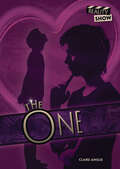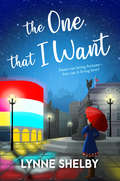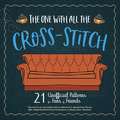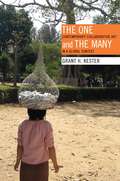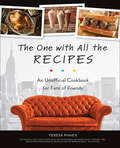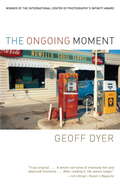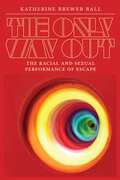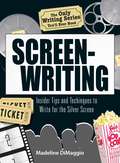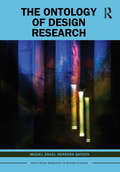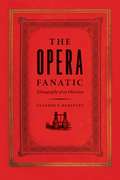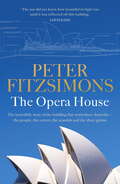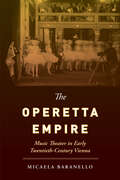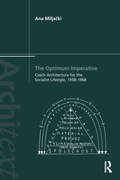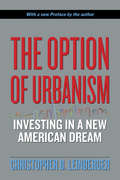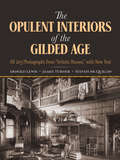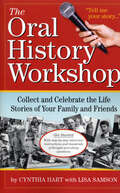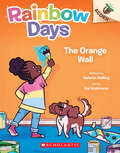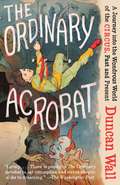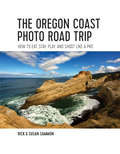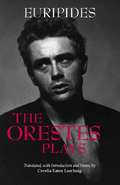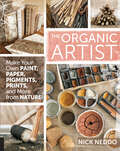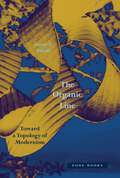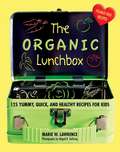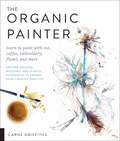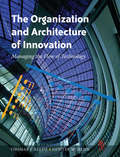- Table View
- List View
The One (Reality Show)
by Claire AinslieHer friend signed her up for a reality dating show as a joke, but when Charlotte is selected, she decides to go ahead with it, in the hopes of winning a scholarship. The four contestants have to win over Dominic, and at first he is exactly like she expected him to be—an arrogant player. But when she gets to know him behind the scenes, he seems like a great guy. As she develops feelings for him, she begins to question her motivations. Maybe true love really can be found, even in the middle of a fraud.
The One That I Want: The Theatreland Series (The Theatreland Series #1)
by Lynne ShelbyFame can bring fortune - but can it bring love?'Warm-hearted, romantic, and beautifully written' KATE FIELD, author of A Place to Begin AgainWhen Lucy Ashford lands a top job at a leading theatrical agency in London, work mixes with pleasure, as she literally falls into the arms of Hollywood heartthrob Daniel Miller.Handsome, charming and irresistible, Daniel is just what unlucky-in-love Lucy needs, and she is quickly drawn into his glittering celebrity lifestyle. But can she tame the A-list bad boy or is she just one more girl in Daniel s long line of conquests?And then there's up-and-coming actor Owen Somers, fiercely talented but as yet uncast in a starring role. After she takes him onto the agency's books, Owen and Lucy's friendship slowly grows. If she looks closely, Lucy's leading man might be right before her very eyes...________Readers LOVE Lynne's swoon-worthy romances:'Well this is a wonderfully, romantic story! This is the first book I have read by Ms Shelby and I thoroughly enjoyed it, and I am looking forward to reading more from this talented author. The One That I Want is fun, entertaining and very romantic' Amazon reviewer'Shelby's writing style transports you so completely into the world of her characters that I actually dreamt about Owen Somers! I loved reading this book and found it to be the perfect balance of romantic, unpredictable and fast paced. I really didn't want it to end' Amazon reviewer'This was a perfect weekend read. It whisked me away from rainy reality to the glamorous celebrity world in London... The story raced along with plenty of twists and turns; I had no idea how it was going to end, or which way I wanted it to end. Warm-hearted, romantic and beautifully written - I loved it' Amazon reviewer'Lynne Shelby has given us a glamorous, fun and compulsive read in her fabulous The One That I Want. I was rooting for the heroine Lucy all the way through and enjoyed every twist and turn of the plot... I thoroughly recommend this fresh, sparkling book - it's the one that you want!' Amazon reviewer'A believable and fun escape into the world of celebrity and showbiz... Very enjoyable read, with a most satisfactory ending' Amazon reviewer'A very well told story, of things that glitter brightly , but are rarely gold. Lovely believable charters with a good dollop of romance' Amazon reviewer'I really enjoyed this book. Lovely characters, lovely story and very well written. I will buy more books by this author' Amazon reviewer
The One With All the Cross-Stitch: 21 Unofficial Patterns for Fans of Friends
by Editors of Ulysses PressGet stitching with this adorable collection of cross-stitch patterns inspired by the greatest TV show of all time: FRIENDS!The One with All the Cross-Stitch brings your favorite TV sitcom to the craft space in a first-of-its-kind cross-stitch book! Crafty fans of FRIENDS will love this adorable book and its 25 clever cross-stitch patterns that pay homage to one of the most binged shows ever. With this book, you&’ll be able to relive the very best moments of FRIENDS as you stitch together iconic images like the Central Perk sign, the chick and the duck, and unforgettable quotes like &“PIVOT!&” Whether you&’re making fabulous wall art to proudly display your FRIENDS superfandom or one-of-a-kind handmade gifts for your friends and family, this cross-stitch book is a must-have for any die-hard lover of FRIENDS.
The One and the Many: Contemporary Collaborative Art in a Global Context
by Grant H. KesterCollaborative and collective art practices have proliferated around the world over the past fifteen years. In The One and the Many, Grant H. Kester provides an overview of the broader continuum of collaborative art, ranging from the work of artists and groups widely celebrated in the mainstream art world, such as Thomas Hirschhorn, Superflex, Francis Als, and Santiago Sierra, to the less-publicized projects of groups, such as Park Fiction in Hamburg, Networking and Initiatives for Culture and the Arts in Myanmar, Ala Plastica in Argentina, Huit Facettes in Senegal, and Dialogue in central India. The work of these groups often overlaps with the activities of NGOs, activists, and urban planners. Kester argues that these parallels are symptomatic of an important transition in contemporary art practice, as conventional notions of aesthetic autonomy are being redefined and renegotiated. He describes a shift from a concept of art as something envisioned beforehand by the artist and placed before the viewer, to the concept of art as a process of reciprocal creative labor. The One and the Many presents a critical framework that addresses the new forms of agency and identity mobilized by the process of collaborative production.
The One with All the Recipes: An Unofficial Cookbook for Fans of Friends
by Teresa FinneyCould this BE any more delicious?You&’re the ultimate fan of Friends. You&’ve seen every episode (multiple times). You get all the inside jokes. You even know how to make that trifle. But with this fun and funny cookbook, you can take your fandom one step further by whipping up incredible entrées inspired by this iconic 1990s sitcom. You know one person who doesn&’t share food, but you can share yours! This cookbook is packed with delicious recipes that are perfect for you and your own friends to enjoy together. Whether it&’s a going away party when you move to Yemen, a Friendsgiving dinner in your unaffordable NYC apartment, or just having some nibbles during a binge viewing party, The One with All the Recipes will be there for you with: • Not-So-Fine Margaritas • Engagement Ring Lasagna • &“French Aunt&” Chocolate Chip Cookies • Thanksgiving Turkey for One • Fried Stuff with Cheese • Perfect Pox Peach CobblerIf you're a fan of cookbooks such as Bob's Burgers, Game of Scones, or the Gilmore Girls Eat Like a Gilmore, you'll love this ultimate tribute to the greatest sitcom ever written!
The Ongoing Moment
by Geoff DyerGreat photographs change the way we see the world; The Ongoing Moment changes the way we look at both. Focusing on the ways in which canonical figures like Alfred Stieglitz, Paul Strand, Walker Evans, Andre Kertesz, Edward Weston, Dorothea Lange, Diane Arbus, and William Eggleston have photographed the same things--barbershops, benches, hands, roads, signs--award-winning writer Geoff Dyer seeks to identify their signature styles. In doing so, he constructs a narrative in which these photographers--many of whom never met--constantly encounter one another. The result is a kaleidoscopic work of extraordinary originality and insight.
The Only Way Out: The Racial and Sexual Performance of Escape
by Katherine Brewer BallIn The Only Way Out, Katherine Brewer Ball explores the American fascination with the escape story. Brewer Ball argues that escape is a key site for exploring American conceptions of freedom and constraint. Stories of escape are never told just once but become mythic in their episodic iterations, revealing the fantasies and desires of society, the storyteller, and the listener. While white escape narratives have typically been laden with Enlightenment fantasies of redemption where freedom is available to any individual willing to seize it, Brewer Ball explores how Black and queer escape offer forms of radical possibility. Drawing on Black studies, queer theory, and performance studies, she examines a range of works, from nineteenth-century American literature to contemporary queer of color art and writing by contemporary American artists including Wilmer Wilson IV, Tourmaline, Tony Kushner, Junot Díaz, Glenn Ligon, Toshi Reagon, and Sharon Hayes. Throughout, escape emerges as a story not of individuality but of collectivity and entanglement.
The Only Writing Series You'll Ever Need: Insider Tips and Techniques to Write for the Silver Screen!
by Madeline DiMaggioThe insider info you need!Writing scripts for the big screen takes more than a big idea--it requires passion, perseverance, and insider know-how. The Only Writing Series You'll Ever Need: Screenwriting is your go-to resource for mastering the complete screenwriting process. Taking you step by step from idea to deal, you'll learn how to:Write a sellable scriptCreate real and credible dialogFind an agent and market the script the right wayEdit and revise--over and over and over againLive the life of a full-time screenwriterIdeal for those writers who want to perfect their craft and shop their script around, The Only Writing Series You'll Ever Need: Screenwriting is your break into this exciting career!
The Ontology of Design Research (Routledge Research in Design Studies)
by Miguel Ángel Herrera BatistaThis book seeks to establish the meaning of design research, its role in the field, and the characteristics that differentiate research in design from research in other fields. The author introduces a model to explain the relationship between the components of the ontological reality of design: the designed object, the designer, and the user. Addressing design research across disciplines, the author establishes a foundational understanding of research, and research paradigms, for the design disciplines. This will be crucial for the emerging field of design research to find its own identity and move forward, building its own knowledge base as it finds its positioning between science and art. The book will be of interest to scholars working in design history, design studies, graphic design, industrial design, interior design, architecture, fashion design, and service design.
The Opera Fanatic: Ethnography of an Obsession
by Claudio E. BenzecryThough some dismiss opera as old-fashioned, it shows no sign of disappearing from the world’s stage. So why do audiences continue to flock to it? Given its association with wealth, one might imagine that opera tickets function as a status symbol. But while a desire to hobnob with the upper crust might motivate the occasional operagoer, for hardcore fans the real answer, according to The Opera Fanatic, is passion—they do it for love. Opera lovers are an intense lot, Claudio E. Benzecry discovers in his look at the fanatics who haunt the legendary Colón Opera House in Buenos Aires, a key site for opera’s globalization. Listening to the fans and their stories, Benzecry hears of two-hundred-mile trips for performances and nightlong camp-outs for tickets, while others testify to a particular opera’s power to move them—whether to song or to tears—no matter how many times they have seen it before. Drawing on his insightful analysis of these acts of love, Benzecry proposes new ways of thinking about people’s relationship to art and shows how, far from merely enhancing aspects of everyday life, art allows us to transcend it.
The Opera House: The extraordinary story of the building that symbolises Australia — the people, the secrets, the scandals and the sheer genius
by Peter FitzSimons'The sun did not know how beautiful its light was until it was reflected off this building.' - Louis Kahn, US architect If only these walls and this land could talk ... The Sydney Opera House is a breathtaking building, recognised around the world as a symbol of modern Australia. Along with the Taj Mahal and other World Heritage sites, it is celebrated for its architectural grandeur and the daring and innovation of its design. It showcases the incomparable talents involved in its conception, construction and performance history. But this stunning house on Bennelong Point also holds many secrets and scandals. In his gripping biography, Peter FitzSimons marvels at how this magnificent building came to be, details its enthralling history and reveals the dramatic stories and hidden secrets about the people whose lives have been affected, both negatively and positively, by its presence. He shares how a conservative 1950s state government had the incredible vision and courage to embark on this nation-defining structure; how an architect from Denmark and construction workers from Australia and abroad invented new techniques to bring it to completion; how ambition, betrayal, professional rivalry, sexual intrigue, murder, bullying and breakdowns are woven into its creation; and how it is now acknowledged as one of the wonders and masterpieces of human ingenuity. In The Opera House, Peter FitzSimons captures the extraordinary stories around this building that are as mesmerising as the light catching on its white sails.
The Operetta Empire: Music Theater in Early Twentieth-Century Vienna
by Micaela Baranello"When the world comes to an end," Viennese writer Karl Kraus lamented in 1908, "all the big city orchestras will still be playing The Merry Widow." Viennese operettas like Franz Lehár's The Merry Widow were preeminent cultural texts during the Austro-Hungarian Empire's final years. Alternately hopeful and nihilistic, operetta staged contemporary debates about gender, nationality, and labor. The Operetta Empire delves into this vibrant theatrical culture, whose creators simultaneously sought the respectability of high art and the popularity of low entertainment. Case studies examine works by Lehár, Emmerich Kálmán, Oscar Straus, and Leo Fall in light of current musicological conversations about hybridity and middlebrow culture. Demonstrating a thorough mastery of the complex early twentieth-century Viennese cultural scene, and a sympathetic and redemptive critique of a neglected popular genre, Micaela Baranello establishes operetta as an important element of Viennese cultural life—one whose transgressions helped define the musical hierarchies of its day.
The Optimum Imperative: Czech Architecture for the Socialist Lifestyle, 1938–1968 (Architext)
by Ana MiljackiThe Optimum Imperative examines architecture’s multiple entanglements within the problematics of Socialist lifestyle in postwar Czechoslovakia. Situated in the period loosely bracketed by the signing of the Munich accords in 1938, which affected Czechoslovakia’s entrance into World War II, and the Warsaw Pact troops’ occupation of Prague in 1968, the book investigates three decades of Czech architecture, highlighting a diverse cast of protagonists. Key among them are the theorist and architect Karel Honzík and a small group of his colleagues in the Club for the Study of Consumption; the award-winning Czechoslovak Pavilion at the 1958 World Expo in Brussels; and SIAL, a group of architects from Liberec that emerged from the national network of Stavoprojekt offices during the reform years, only to be subsumed back into it in the wake of Czechoslovak normalization. This episodic approach enables a long view of the way that the project of constructing Socialism was made disciplinarily specific for architecture, through the constant interpretation of Socialist lifestyle, both as a narrative framework and as a historical goal. Without sanitizing history of its absurd contortions in discourse and in daily life, the book takes as its subject the complex and dynamic relationships between Cold War politics, state power, disciplinary legitimating narratives, and Czech architects’ optimism for Socialism. It proposes that these key dimensions of practicing architecture and building Socialism were intertwined, and even commensurate at times, through the framework of Socialist lifestyle.
The Option of Urbanism: Investing in a New American Dream
by Christopher B. LeinbergerAmericans are voting with their feet to abandon strip malls and suburban sprawl, embracing instead a new type of community where they can live, work, shop, and play within easy walking distance. In The Option of Urbanism visionary developer and strategist Christopher B. Leinberger explains why government policies have tilted the playing field toward one form of development over the last sixty years: the drivable suburb. Rooted in the driving forces of the economy--car manufacturing and the oil industry--this type of growth has fostered the decline of community, contributed to urban decay, increased greenhouse gas emissions, and contributed to the rise in obesity and asthma. Highlighting both the challenges and the opportunities for this type of development, The Option of Urbanism shows how the American Dream is shifting to include cities as well as suburbs and how the financial and real estate communities need to respond to build communities that are more environmentally, socially, and financially sustainable.
The Opulent Interiors of the Gilded Age: All 203 Photographs from "Artistic Houses," with New Text (Dover Architecture)
by James Turner Arnold Lewis Steven McQuillinOriginally published in 1883 to 1884, Artistic Houses comprised more than 200 photographs of the interiors of the homes of the well-to-do, with commentary on the woodwork, wall coverings, color schemes, and other aspects of interior décor. Today, historians consider Artistic Houses the best source of information and illustrations for private houses in major Eastern cities in the early 1880s. Although its authorship is not certain, the text is generally attributed to noted author and art critic George William Sheldon.This volume retains all of the photographs from the original two-volume work; the text, however, has been replaced with a version specially written for this edition. In addition to an introductory essay on the period's social and esthetic trends, extensive captions for each plate include most of the valuable information from Sheldon's descriptions plus biographical comments on the homeowners and their families, comments on paintings and sculptures, present condition of the houses, and locations.Over 200 photographs of 97 grand buildings include rare photographs of the New York homes of Hamilton Fish and Ulysses S. Grant; multiple views of the Henry Villard house, now part of the Helmsley Palace Hotel in Manhattan; rooms from William H. Vanderbilt's Fifth Avenue residence; interiors from J. Pierpont Morgan's Madison Avenue home; the Marshall Field house in Chicago, and many others. Here are richly paneled rooms that rivaled the baronial halls of European castles, miniature art galleries, magnificent tapestries, plush draperies, and brilliant chandeliers. With its thorough scholarship and wealth of detail, this impressive survey offers not only inside views of the homes of the rich and powerful families during the Gilded Age but also fascinating insights into the social history and architectural development of the United States.
The Oral History Workshop: Collect and Celebrate the Life Stories of Your Family and Friends
by Lisa Samson Cynthia HartWe all know that we should ask now, before it's too late, before the stories are gone forever. But knowing and doing are two different things.Cynthia Hart, author of Cynthia Hart's Scrapbook Workshop, shows exactly how to collect, record, share, and preserve a family member's or a friend's oral history in this practical and inspirational guide. The Oral History Workshop breaks down what too often feels like an overwhelming project into a series of easily manageable steps: how to prepare for an interview; how to become a better listener; why there's always more beneath the surface and the questions to ask to get there; the pros and cons of video recording, including how your subjects should dress so the focus is on their words; four steps to keeping the interview on track; how to be attentive to your subject's energy levels; and the art of archiving or scrapbooking the interview into a finished keepsake.At the heart of the book are hundreds of questions designed to cover every aspect of your subject's history: Do you remember when and how you learned to read? Who in your life showed you the most kindness? What insights have you gained about your parents over the years? Would you describe yourself as an optimist or a pessimist? In what ways were you introduced to music? What is the first gift you remember giving? If you could hold on to one memory forever, what would it be? When the answers are pieced together, a mosaic appears—a living history.
The Orange Wall: An Acorn Book (Rainbow Days)
by Valerie BollingZoya and her puppy Coco are excited for a glittery bedroom makeover in this full-color book perfect for beginning readers!Pick a book. Grow a Reader!This series is part of Scholastic's early reader line, Acorn, aimed at children who are learning to read. With easy-to-read text, a short-story format, plenty of humor, and full-color artwork on every page, these books will boost reading confidence and fluency. Acorn books plant a love of reading and help readers grow!Zoya can't wait to paint her bedroom a new glittery color. But Zoya can't decide on just one color! So she decides she wants a fun, multi-colored room! Will Zoya -- with her puppy Coco's help -- be able to give her bedroom the perfect makeover? With Kai Robinson's vibrant, full-color artwork and Valerie Bolling's engaging, easy-to-read text throughout, this sparkly series is perfect for beginning readers!
The Ordinary Acrobat: A Journey into the Wondrous World of the Circus, Past and Present
by Duncan WallThe extraordinary story of a young man's plunge into the unique and wonderful world of the circus--taking readers deep into circus history and its renaissance as a contemporary art form, and behind the (tented) walls of France's most prestigious circus school. When Duncan Wall visited his first nouveau cirque as a college student in Paris, everything about it--the monochromatic costumes, the acrobat singing Simon and Garfunkel, the juggler reciting Proust--was captivating. Soon he was waiting outside stage doors, eagerly chatting with the stars, and attending circuses two or three nights a week. So great was his enthusiasm that a year later he applied on a whim to the training program at the École Nationale des Arts du Cirque--and was, to his surprise, accepted. Sometimes scary and often funny, The Ordinary Acrobat follows the (occasionally literal) collision of one American novice and a host of gifted international students in a rigorous regimen of tumbling, trapeze, juggling, and clowning. Along the way, Wall introduces readers to all the ambition, beauty, and thrills of the circus's long history: from hardscrabble beginnings to Gilded Age treasures, and from twentieth-century artistic and economic struggles to its brilliant reemergence in the form of contemporary circus (most prominently through Cirque du Soleil). Readers meet figures past--the father of the circus, Philip Astley; the larger-than-life P. T. Barnum--and present, as Wall seeks lessons from innovative masters including juggler Jérôme Thomas and clown André Riot-Sarcey. As Wall learns, not everyone is destined to run away with the circus--but the institution fascinates just the same. Brimming with surprises, outsized personalities, and plenty of charm, The Ordinary Acrobat delivers all the excitement and pleasure of the circus ring itself.
The Oregon Coast Photo Road Trip: How To Eat, Stay, Play, And Shoot Like A Pro
by Rick SammonCapture the incredible sights of Oregon’s majestic seaside Rick and Susan Sammon are back to share their seasoned photography and travel wisdom, this time guiding the reader through the remarkable landscapes and cultural treasures of the Oregon Coast, from Cannon Beach to Bandon Beach. Whether toting professional gear or just smartphones, travelers will find practical tips and expert knowledge on taking the best photos of the coast’s shorelines, rock faces, lighthouses, and more. When the journey is over, The Oregon Coast Photo Road Trip offers photo editing advice for everything from industry-leading software to a smartphone’s default camera app, so the memories can be relived and preserved. More than just guides to the practice of photography, Rick and Susan also cover all of the best places to lodge, dine, and shop, providing a detailed and tailored itinerary and map so travelers can make the most of every mile of coast.
The Orestes Plays
by Euripides Cecelia Eaton LuschnigFeaturing Cecelia Eaton Luschnig's annotated verse translations of Euripides' Electra, Iphigenia among the Tauri, and Orestes, this volume offers an ideal avenue for exploring the playwright's innovative treatment of both traditional and non-traditional stories concerning a central, fascinating member of the famous House of Atreus.
The Organic Artist: Make Your Own Paint, Paper, Pigments, Prints, and More from Nature
by Nick NeddoDrawing on ancient techniques, a primitive-arts instructor shows how to reconnect with nature by making and using your own all-natural art supplies.The Organic Artist encourages you to return to those days when art was made with all-natural materials, like charcoal and birch bark. Immersing you in the natural world, this book seeks to inspire creativity by connecting you to your organic roots.In addition to offering a wide variety of suggestions for using nature as supplies for art, this book also introduces the concepts of awareness and perception that are foundational to the creative process. You can refine your drawing skills, as well as increase their appreciation for the visual arts and the natural landscape. Projects and skills covered include:Making paper and wild inkWorking with soapstone, clay, wood, and rawhidePrintmaking and stencilingNatural pigments and dyesCamouflage and body paintingNature journaling, and more“Clear, concise and easy to follow . . . a pleasure to both use as a how-to book and read through.” —Michael Pewtherer, author of Wilderness Survival Handbook
The Organic Line: Toward a Topology of Modernism
by Irene V. SmallA major rethinking of twentieth-century abstract art mobilized by the work of Brazilian artist Lygia ClarkWhat would it mean to treat an interval of space as a line, thus drawing an empty void into a constellation of art and meaning-laden things? In this book, Irene Small elucidates the signal discovery of the Brazilian artist Lygia Clark in 1954: a fissure of space between material elements that Clark called &“the organic line.&” For much of the history of art, Clark&’s discovery, much like the organic line, has escaped legibility. Once recognized, however, the line has seismic repercussions for rethinking foundational concepts such as mark, limit, surface, and edge. A spatial cavity that binds discrepant entities together, the organic line transforms planes into flexible topologies, borders into membranes, and interstices into points of connection. As a paradigm, the organic line has profound historiographic implications as well, inviting us to set aside traditional notions of influence and origin in favor of what Small terms weak links and plagiotropic relations. These fragile, oblique, and transversal ties have their own efficacy, and Small&’s innovative readings of canonical modernist works such as Kazimir Malevich&’s Black Square, John Cage&’s 4&’33&”, and Le Corbusier&’s machine-à-habiter, as well as contemporary works by such artists as Adam Pendleton, Ricardo Basbaum, and Mika Rottenberg, reveal the organic line&’s remarkable potential as an analytic instrument. Mobilizing a rich repertoire of archival sources and moving across multiple chronologies, geographies, and disciplines, this book invites us to envision modernism not as a stable construct defined by centers and peripheries, inclusions and exclusions, but as a topological field of interactive, destabilizing tensions. More than a history of a little-known artistic device, The Organic Line: Toward a Topology of Modernism is a user&’s guide and manifesto for reimagining modern and contemporary art for the present.
The Organic Lunchbox: 125 Yummy, Quick, and Healthy Recipes for Kids
by Marie W. LawrenceTaking the mystery out of making nutritious meals that your kids will love, The Organic Lunchbox has a variety of options that are sure to tantalize even the most finicky taste buds. Divided into categories, including Breakfast for Lunch, Hot or Cold, Vegetables on Parade, Soups and Sandwiches, and Something Not Too Sweet, you’ll find fun and often finger-friendly fare such as: Classic mini pizzasBroccoli cheese soupSweet potato chipsCrunchy French toast fingersMeatloaf cupcakesLemon-lime gel with blueberriesThe easy-to-follow recipes, many of which are geared to kid- or family-friendly preparation, will include peanut-free and tree nut-free options. In addition, The Organic Lunchbox will include information on purchasing and utilizing organic ingredients and tips on which types of food are most important to consider when looking for the organic designation. Lawrence also offers helpful suggestions for making kid-size portions, serving options, and storing until they’re ready to be packed into a lunchbox.
The Organic Painter: Learn to Paint with Tea, Coffee, Embroidery, Flame, and More
by Carne GriffithsFind new creative possibilities with unconventional media—using innovative techniques to turn everyday materials into non-traditional, natural “paints.”Traditional art supplies will only take you so far! Sometimes you need to try something completely new and different. With the guidance in The Organic Painter, you’ll soon be painting with everyday materials you’d never considered as an artistic medium.This inspiring book gives you all the techniques and ideas you’ll need to boost your creativity, learn natural paint-making, and be more resourceful with your art materials. Imagine the unique things you’ll make when you create natural paints from coffee, tea, embroidery thread, flame, and more.Each project in this guidebook comes with instructions on how to make the paint, and also includes experiments and explorations for you to try. Plus, a simple painting accompanies every featured material and combines it with other materials or techniques—so you’ll never lack inspiration.
The Organization and Architecture of Innovation
by Thomas Allen Gunter HennBuilding on his pioneering work on the management of technology and innovation in his first book, Managing the Flow of Technology, Thomas J. Allen of MIT has joined with award-winning German architect Gunter Henn of HENN Architekten to produce a book that explores the combined use of two management tools to make the innovation process most effective: organizational structure and physical space. They present research demonstrating how organizational structure and physical space each affect communication among people—in this case, engineers, scientists, and others in technical organizations—and they illustrate how organizations can transform both to increase the transfer of technical knowledge and maximize the “communication for inspiration” that is central to the innovation process. Allen and Henn illustrate their points with discussions of well-known buildings around the world, including Audi’s corporate headquarters, Steelcase’s corporate design center, and the Corning Glass Becker building, as well as several of Gunter Henn’s own projects, including the Skoda automotive factory in the Czech Republic and the Faculty for Mechanical Engineering at the Technical University of Munich. Allen and Henn then demonstrate the principles developed in their work by discussing in detail one example in which organizational structure and physical space were combined successfully to promote innovation with impressive results: HENN Architekten’s Project House for the BMW Group Research and Innovation Centre in Munich, cited by Business Week (April 24, 2006) in naming BMW one of the world’s most innovative companies.Professor Thomas Allen is the originator of the Allen curve. In the late 1970s, Tom Allen undertook a project to determine how the distance between engineers’ offices coincided with the level of regular technical communication between them. The results of that research, now known as the Allen Curve, revealed a distinct correlation between distance and frequency of communication (i.e. the more distance there is between people — 50 meters or more to be exact — the less they will communicate). This principle has been incorporated into forward-thinking commercial design ever since, in, for example, The Decker Engineering Building in New York, the Steelcase Corporate Development Center in Michigan, and BMW’s Research Center in Germany.
